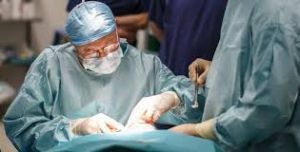 In addition to external asymmetric manifestations, an incorrect bite prevents full chewing and swallowing of food. More serious deviations from the norm can cause disturbances in the functioning of the speech apparatus and even damage the temporomandibular joint.
In addition to external asymmetric manifestations, an incorrect bite prevents full chewing and swallowing of food. More serious deviations from the norm can cause disturbances in the functioning of the speech apparatus and even damage the temporomandibular joint.
Some situations associated with abnormal development of the dental system can be resolved by surgery.
Contents
- Indications and contraindications for operation
- Methods and features used for correction
- Steps of operation
- Recovery period
- Opinion of patients of the dental clinic
- Risks and complications
- Cost of operation
Indications and contraindications for the operation
Most often doctors recommend correction of occlusion surgically to patients, in which the following are observed:
- is a clearly expressed asymmetric face shape;

- considerable deviations in the arrangement of the dentition;
- uncomfortable sensations caused by an incorrectly distributed load on the jaw during meals;
- serious violations in the operation of the speech apparatus;
- deformation of the alveolar processes;
- incomplete closure of lips;
- incorrect location of the tongue in the oral cavity;
- deformation of the cranial arch and severe abnormalities in the development of the upper or lower jaw;
- severe injury to the facial skeleton.
Despite a large number of tasks being solved operatively, surgeons can not always help to correct deficiencies of occlusion due to some limitations. These include:
- pathological changes in the work of cardiovascular, endocrine and other body systems;
- insufficiently high-quality oral hygiene;
- infectious diseases;
- diabetes mellitus;
- disorders related to blood clotting;
- age restrictions - such operations are not carried out by adolescents, since the jaw is not yet fully formed at this age, as for patients older than 60 years, each situation in this case requires separate consideration.
Applied methods and features of correction
Correction of a direct occlusion with the help of an operation is carried out exclusively on the lower jaw.
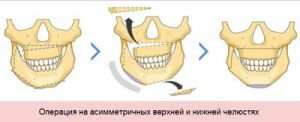 An open frontal bite is corrected by partial removal of bone tissue. Thus, the remaining bone takes its place, after which the tire is applied to fix the correct position of the jaw.
An open frontal bite is corrected by partial removal of bone tissue. Thus, the remaining bone takes its place, after which the tire is applied to fix the correct position of the jaw.
As for the lateral open bite, its change takes place in similar conditions. The surgeon moves the bone in the desired direction and installs special devices( distractors) to extend it.
Long orthodontic therapy is performed before the deep bite correction surgery. In some cases, the doctor may even recommend removing one or more teeth.
The movement of bones is also carried out under general anesthesia, and the result achieved is fixed accordingly. However, therapy does not end there. Correction orthodontic treatment is required for complete recovery.
In chin dysplasia( pronounced defects in the lower part of the facial skeleton), in addition to the operation, it may be necessary to use medicines.
Stages of operation
The surgical modification of the bite is carried out in several stages:
- Introduction of the anesthetic .Before the operation, the doctor collects the patient's anamnesis and draws conclusions based on the manifestation or absence of allergic reactions. Drugs of general anesthesia are administered only under the supervision of an anesthesiologist and are calculated based on the time it will take to conduct all necessary manipulations. This can take from one to several hours.
- Cutting of fabrics .Special tools the surgeon makes neat cuts in order to open access to the bone.
- Permutation and fixing of .At this stage, the bone is moved in the desired direction and its fixation in the new area with the help of plates and screws.
- Overlay of the .In order for the jaws to get used to the new position relative to each other, they are additionally fixed by the tire.
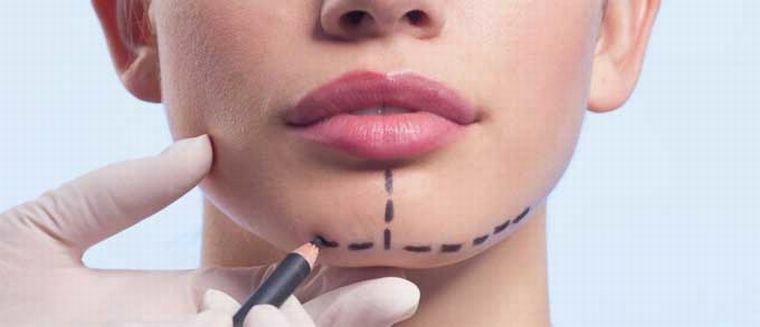
Depending on the general condition of the dental system, in addition to surgical intervention, it may be necessary to install orthodontic structures.
Recovery period
After surgery, the cheeks and chin of the patient are fixed with a tight bandage. Immediately, an antibiotic is introduced, the course of which is designed for several days.
For some time after the operation, there may be difficulties with speech and external manifestations of microtrauma in the form of bruises. The main 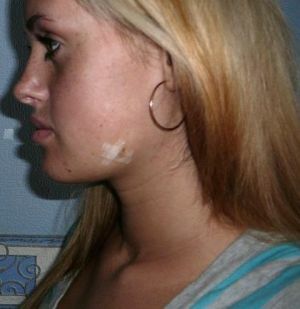 the moment of rehabilitation is the transition to a new diet.
the moment of rehabilitation is the transition to a new diet.
After the anesthesia effect has gradually weakened, the patient may feel discomfort when moving the jawbones and numbness in the face area. Under the supervision of the attending physician, such symptoms pass quickly enough.
The main rule that must be followed during this period is the strict adherence to the recommendations of specialists responsible for the effectiveness of the process.
Over the next two weeks, doctors will carefully monitor the condition of the joints and the position of the rubber bands in the oral cavity. Then the seams are removed, and the elastic bands are attached to the brackets. Not earlier than in 3 months the doctor can decide to remove the screws from the jaw.
Opinion of the patients of the dental clinic
Not everything is so terrible, although painful, judging by the reviews of patients who have been corrected by bite in one or another surgical way.
Two years ago I decided on such an operation and do not regret it. I successfully had an osteotomy of both jaws and a correction of the chin.
Before surgery, I was wearing braces for a year and a half. Of course, the rehabilitation period had its own nuances. I could take food only in liquid form, through a tube. By the way, I was very useful bibs, because after the operation, the jaw bone can not be completely controlled.
On the third day after correction, the facial puffiness increased and it became even more difficult for me to open my mouth, there was pain. I removed the bandage, fixed the elastic band on the microimplant and let it go home. Medications that were discharged, I previously dissolved in water, and then I took it as intended.
Lips did not listen to me very much, but the doctor said that they should be dealt with and gradually developed. To me have appointed or nominated a microcurrent procedure thanks to which the pain has gone and slept puffiness. After two weeks, I started to eat with a spoon, then they took off my gum, and I began to re-learn how to chew food.
A month after the operation, I removed the stitches and removed the microimplants. I'm glad that I decided on such changes!
Svetlana
Just over a month ago I was successfully operated under general anesthesia. Before that I had 15 months of lingual braces to correct the distal occlusion and was pleased with the intermediate result.
The operation took place in the orthodontic clinic of St. Petersburg under the guidance of an experienced specialist. It took about 3 hours. Adverse reactions after anesthesia I completely absent. Jaws fixed with elastic only the next day.
At first, only liquid food is allowed( I have adapted to baby food and dairy products), which should not be chewed. She took antibiotics regularly. Puffiness and loss of sensitivity in some areas of the face are minor drawbacks of the post-operation period.
Two weeks later I was ready to go to work. I was unscrewed by microimplants and I was given turnout one month after the operation. The last inspection convinced me that we are moving in the right direction. Despite the fact that the correction of the defect is not over yet, I am only set for a positive result!
Marina
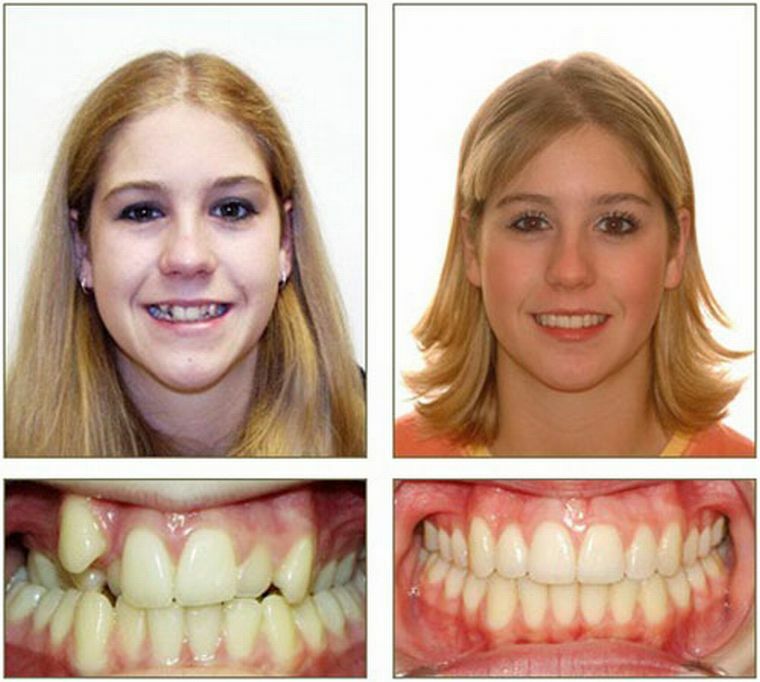
Photo before and after osteotomy
Risks and complications of
As a whole team of specialists works to eliminate serious anomalies of the dentoalveolar system, each of them tries to minimize the unpleasant consequences of surgical intervention. So, to prevent infection, special drug support is provided, and anesthetic preparations are selected individually. However, complications of various nature may occur after surgery:
- Swelling of tissues .The most severe manifestations of edema are observed 2-3 days after the operation. Then the swelling slowly subsides and the face gradually acquires its new forms.
- Dizziness and nausea .Thus, the body can react to general anesthesia.
- Pain .Painful sensations are accompanied by absolutely all serious surgical interventions, therefore they relate to inconveniences rather than complications.
- Inflammatory processes in the tissues of .They can arise because of overloading of the jaw bones and its subsequent displacement.
- Deviations in the operation of the speech device. Serious speech disorders need to be corrected with the help of specialists. Minor defects eventually leave themselves.
- Seam divergence .If there are significant discrepancies in the suture material, the surgeon may decide to reinstall the tissue.
Video report of a girl who underwent an operation on the jaw to correct the bite.
The first three days after the operation, they are the heaviest. ...
Then it's easier. ..
Half a year later:
Result on face:
Cost of operation
The cost of correcting the bite with the help of an operative intervention usually depends on the package of services that the patient intends to use.
Dental clinics prefer to sound an approximate amount, which includes: preliminary examination and treatment, the operation itself, all the necessary drugs and monitoring the recovery.
On average, all of the above manipulations will cost the patient 300-450 thousand rubles.
